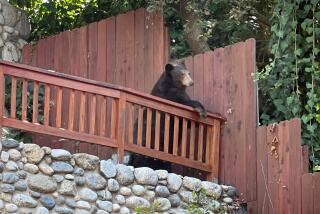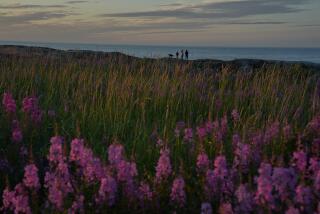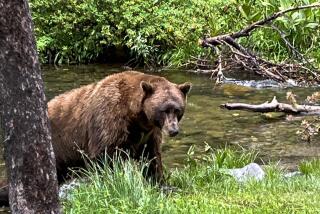ALASKA / PACIFIC NORTHWEST : Alaska’s WILD KINGDOM : BEARS: SALMON TIME AND THE LIVIN’ IS EASY IN KATMAI NAT’L PARK
KATMAI NATIONAL PARK AND PRESERVE, Alaska — To my mind, the brown bear defines Alaska’s wilderness. Maybe it’s because humans aren’t the boss here. There is still a towering predator patrolling this landscape, and that cold reality electrifies every foray into the Alaska back country.
Last summer was my 21st in Alaska. The joy of each has been the time spent on a stream bank, watching a 1,000-pound bear stumble after salmon. I do this for the soul, mainly, but also for the serenity. Bear watching is a lonely undertaking. Alaska’s 1 million summer tourists always seem to be somewhere else. It’s not for lack of interest--bear talk animates every Alaska tour group. But bear watching is a cottage industry often missed by the mainstream tourist business.
To compound matters, Alaska’s 30,000 brown bears--or grizzlies, if you prefer--are distributed quite unevenly. For those with less than 21 Alaska summers to sort it out, the obstacles are imposing. In fact, it was only last summer that even I finally got it right.
The venues for my bear-watching expedition were a small camp and quaint boat in southwest Alaska’s Katmai National Park and Preserve. Katmai’s myriad streams and lakes empty into the world’s richest salmon fishery. Katmai bears live long and have friends. On July 20, 1990, 68 bears were seen dining together at Alaska’s McNeil River Sanctuary just east of Katmai. That statewide record still stands, though, knowing Katmai, I doubt it’s unbreakable.
Katmai shows its bears on two very different stages. The park’s southern border spans 200 miles of rough coastline. Here the gray North Pacific slams against 1,000-foot cliffs, and rich green-water bays cut deep into coastal mountainsides. Sea-carved islands are a chaos of puffins, cormorants and kittiwakes; fat sea otters ride the swells while sucking on crab legs. By and large, the bear show here goes unseen.
To the north, across the 7,000-foot Aleutian Range, are rolling tundra hills dropping gently into vast lakes and long, waltzing rivers. Hikers come here to bounce atop lichen; the gentry come to drop a fly line. It is rich in all things natural here, from caribou to 10-pound rainbow trout.
*
I found the quaint boat and small camp by word of mouth. The boat was a 1944, 73-foot tugboat called the M/V Waters. In 1989, John Rogers and Mike Yourkowski, fishermen from the town of Homer, bought the tug without a firm notion of what to do with it. The boat was used for damage assessment research following the 1989 Exxon Valdez spill. For the long run, its owners hoped the tug might make a fine support vessel for the region’s commercial fishing fleet.
By 1993, however, the research had dried up, and commercial fishing had slowed. The Waters needed a job. For 25 years, Homer pilot Bill deCreeft had shuttled bear watchers across Cook Inlet to the McNeil River campground. DeCreeft also flew National Park Service researchers to the tug.
“What I realized,” deCreeft said, “was that this country was full of bears. In fact, this stretch of coast has the highest known concentration of brown bears per square mile in the world.” And so, partly at deCreeft’s urging, the tug was converted to host fly-in bear watchers.
Throughout the summer, the Waters works three of Katmai’s bear-rich bays--Kukak, Kaflia and Hallo. DeCreeft reaches the boat in his DeHavilland Otter from Homer, which lies 200 miles across Cook Inlet from the park’s coast. The nine-passenger Otter is the largest of Alaska’s fleet of single-engine pontoon planes, and the Waters takes up to six guests, but this August morning’s manifest listed only my wife, son and me; co-owner Rogers, and an Illinoisan named Al Weishar. The Waters’ owners are fine navigators but lousy salesmen, and a single party often has the tug’s services to itself.
The plane droned for 90 minutes over unwelcoming subarctic seas until our drowse was shattered by heaving breakers and great stone cliffs. The Otter dropped into an emerald bay folded snugly into the mountains. The wing dipped toward a shiny, blue boat. A feather-soft landing, a skiff dispatched from the Waters, and we were home.
It is instantly clear that the Waters is not a cruise ship. Its staterooms are cramped; the decks are littered with useful gear. At mealtime, guests and the tug’s four crew members wiggle into a single built-in dining hutch. But the food is grand--as one would expect, given that the fish market lies under the bow.
One evening, after returning from the bears, I noticed an untended halibut pole. I was about to mention the oversight, when the rod jerked roughly, and the mono-filiment sang. I retrieved a 40-pound halibut which, though a dwarf by Alaska measure, amply fed the entire boat the next night.
An hour after arrival, my family, Weishar, Rogers and a retired Fish and Game biologist named Jack Lentfer boarded skiffs and sped to the back of Kaflia Bay, where a salmon stream cascaded down a narrow canyon. Lentfer has lived in Alaska longer than me, and discovered the good life sooner. Today, he pockets his pension, owns a B&B; in Homer and tutors Waters passengers in matters of the bear.
When we arrived, a single brown bear stood at midstream, surveying the menu. We waded ashore and hunkered against the wall of the canyon, about 30 feet from a bear utterly unmoved by our sloshing and tripping. It is improvident to block a bear’s path, so we stayed tight against the rocks to give arriving bears a clear path to the stream. For hours, bears came and went, passing in spitting distance and rendering superfluous my telephoto lens.
Bears generally make poor fishermen. Moreover, it was early in this stream’s run, and fish were few. At these times, bear watching becomes high comedy. Incompetence among giants is endearing--particularly when an exhausted bruin abandons the chase, and finds a slimy rock on which to sprawl and sulk. Less engaging are younger bears, who generally share the demeanor of their teenage human counterparts. They seldom catch fish; they have no patience, and they believe themselves immortal. For those reasons, the sensible bear-watcher gives them ground.
Bear-watching conventions are dictated by escape routes, wind directions and the disposition of the bears. There are no viewing platforms or bear police. Safety depends on the good sense of the guides and guests. The Waters’ guides (who are armed with shotguns) haven’t lacked good sense, and neither bear nor human have ever suffered from the encounter.
Tabloid stories aside, it takes considerable planning to get oneself mauled by a coastal brown bear in the fat days of summer. But the bears make the rules here, and those include: (a) Carry no food, (b) don’t stalk the bears, let them come to you; (c) ensure that the bears know you are there; (d) venture nowhere near a cub, and (e) shun the teenager.
The daily routine aboard the Waters is simple. Mornings and evenings are spent along one stream or another; mid-days are passed either cruising between bays or lolling about the current anchorage, eating and swapping bear tales.
Passengers set priorities on these expeditions, and the decision to relocate always hangs heavy. On the one hand, there are other bears doing other things. Each June, for example, the Hallo Bay bears descend on the tidal flats to dig up six-inch razor clams.
On the other hand, by Day Three, the enveloping peace of this marine wilderness, taken at anchor from a lounge chair on the Waters’ sunny aft deck, becomes hopelessly seductive. A flock of puffins squawks from a rookery; a passing sea lion snorts; the cook inquires about the crab dip. It’s hard to contemplate relocation. The distant whiz of a plane engine changes all that. A faint dot above the rough peaks of the Aleutian Range, it has come to take us to our small camp in Katmai’s interior.
Here is terminal ground for the millions of sockeye salmon that choke Bristol Bay each summer. When the blood-red sockeye reach the interior’s streams, bears from the coast cross the mountain passes to feed on the rich and fatty diet that will see them through the winter. Our destination was an obscure camp called Battle River Wilderness Retreat. From the descending three-passenger Cessna, the camp seemed a caricature of a subarctic research outpost--a 20-by-20-foot tar paper kitchen, two plywood cabins and a radio antenna.
Seeds of doubt sprouted in the little cockpit. The doubts wilted soon after the plane skidded into the camp’s riverside beach. We were embraced by one Matt Conway, who is the brother of Battle’s manager, Tim Conway. From Conway’s enthusiasm at our arrival, you would have thought him my long-lost brother.
Two days later, Conway confided that he could read our reaction from the plane. “To tell you the truth,” he said, “it’s rather typical.” But equally predictable, he added, is each visitor’s metamorphosis. One even coined a phrase that Conway has scrawled on the mess walls: “Battle: So little when you arrive, but so big when you leave.”
*
Battle, indeed, grew larger each passing moment. Tucked in a rolling tundra valley, the camp commands a swath of real estate that stretches from the diamond-clear waters of Battle Lake and Battle River at the camp’s foot, to the tops of distant mountain passes. It’s all the private playground of the camp’s four to six guests and its three- to five-member staff.
The plan is to offer a few guests a private menu of hiking along the tundra ridges, day floats down the Battle River, camp lounging and the certainty of bears. There is no routine at Battle, because the camp runs on the visitors’ whim. And in every instance, a guide is at the visitor’s exclusive disposal.
It was all done mostly out of love for this humble camp--nobody grows rich by flying in groceries and supplies 250 miles from Anchorage for maybe three guests. But the logic of it becomes plain when one stands on the banks of, arguably, the clearest river in the state, and surveys the horizons of one of solitary man’s last outposts.
It is also the last stop for Katmai’s migrating bears. The sockeye salmon begin arriving in late August, and the bears follow. By Labor Day, simply sitting for a couple of hours on the lawn at camp will yield sightings of 10-15 bears. We were the only guests at Battle--like the Waters’ owners, the Conways are not consummate marketers. From the first dinner, Matt, my family and the two-camp staffers broke rank and made a single, family-style table. Like old friends taking a cottage. My son, Jeff, disappeared with the camp’s fishing guide for three days of rainbow trout fishing, while my wife, daughter of a truck driver, helped restart the camp’s all-terrain vehicle.
It occurred to me, in my three days at Battle, that maybe there are two things that define Alaska. The first is the brown bear. The second is folks such as the Conways, Mike Yourkowski and John Rogers, people who weave magic from scrap, and invite a few folks at a time to share it.
For that reason, I will leave it to some newcomer to spend 21 years searching for something better than the one quaint boat, and one small camp I discovered along Alaska’s bear coast in the summer of 1995.
(BEGIN TEXT OF INFOBOX / INFOGRAPHIC)
GUIDEBOOK: Bears Watching
Getting there: From LAX to Anchorage, Alaska, United and Delta offer one-stop service and Reno Air two-stop service, beginning at $480 round trip, advance purchase. ERA Aviation offers a $90 round-trip, advance-purchase fare to Homer, gateway to the Waters tugboat.
The Waters: June 24-Aug. 5, $1,975 per person for two nights. In spring and fall, $1,495 per person, two nights. Includes round-trip air fare from Homer, all meals and guides. Information: Mike Parks, Katmai Coastal Tours, P.O. Box 2939, Homer, AK 99603; tel. (800) 871-7871 or (907) 235-8796.
Battle River Wilderness Retreat: 1,500 per person for three nights, which includes round-trip air fare from Anchorage, all meals and guides. Information: Tim Conway, 2740 Huntington Road, Sacramento, CA 95864; telephone (916) 488-7730.
When to go: For bear viewing purposes, late August or early September is best. For more information: Alaska Division of Tourism, P.O. Box 110801, Juneau, AK 99811-0801; tel. (907) 465-2010. National Park information, Alaska Public Land, 250 Cushman St., Fairbanks, AK 99701; tel. (907) 456-0527.
--J.T.
More to Read
Sign up for The Wild
We’ll help you find the best places to hike, bike and run, as well as the perfect silent spots for meditation and yoga.
You may occasionally receive promotional content from the Los Angeles Times.






